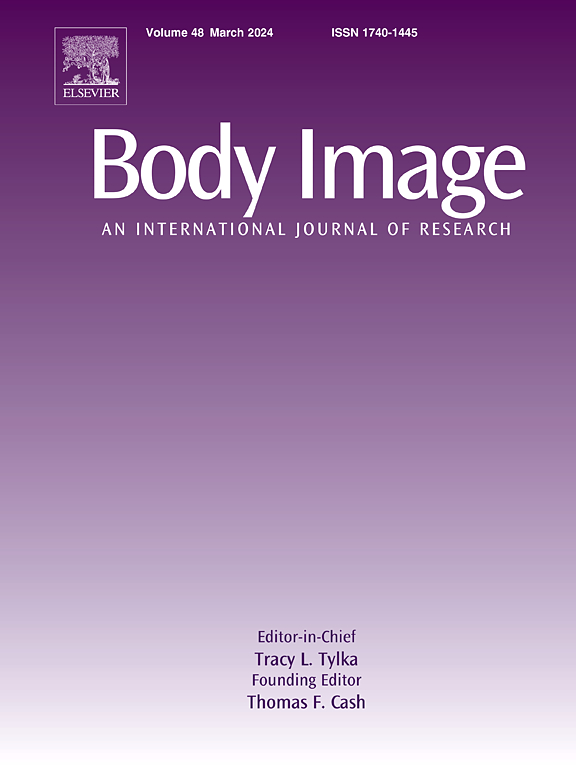自我作为审美对象的加工:一种理解身体畸形障碍的新方法的发展
IF 5.4
1区 心理学
Q1 PSYCHIATRY
引用次数: 0
摘要
理解身体畸形障碍的一个理论模型是将自我加工为审美对象(SAO),其中包括与一个人的外表有关的负面意象体验和羞耻体验。我们的目的是通过心理测量学评估一种新的问卷,SAO,来探索这一概念。在研究1中,80名BDD参与者和102名身体不满意参与者完成了SAO、外观焦虑量表(AAI)和整容程序筛选(COPS)问卷。进行探索性因素分析(EFA),并通过与AAI和cop的相关性评估收敛效度。在研究2中,对另一个临床样本(N = 77)进行了SAO的验证性因子分析(CFA),这些BDD参与者在参加专科门诊评估和治疗之前完成了问卷调查。重新评估收敛效度和内部一致性。研究1中BDD组的EFA在原来12个项目中的11个基础上提出了一个单因素结构。单因素结构的CFA对11项SAO的拟合度比较合理,但有一些拟合度指标不能接受。通过SAO与AAI和cop的中度显著相关,证明了收敛效度。SAO的内部一致性良好(Cronbach 's alpha范围:0.89 - 0.94)。综上所述,我们通过一份新的问卷对自我作为审美对象的加工进行了探索,结果支持了单因素的信度和效度。讨论了几种治疗意义。本文章由计算机程序翻译,如有差异,请以英文原文为准。
The processing of the self as an aesthetic object: Development of a new measure for understanding body dysmorphic disorder
A theoretical model for understanding body dysmorphic disorder is the processing of the self as an aesthetic object (SAO), which includes the experience of a negative imagery in relation to how one looks and the experience of shame. Our aim was to psychometrically evaluate a new questionnaire, the SAO, to explore this concept. In Study 1, 80 participants with BDD and 102 with body dissatisfaction completed the SAO, the Appearance Anxiety Inventory (AAI), and the Cosmetic Procedures Screening (COPS) questionnaires. Exploratory factor analyses (EFA) were conducted, and convergent validity was assessed through correlation with the AAI and COPS. In Study 2, a confirmatory factor analysis (CFA) of the SAO was conducted on another clinical sample (N = 77) of participants with BDD who completed questionnaires prior to attending assessment and treatment at a specialist outpatient clinic. Convergent validity and internal consistency were re-assessed. EFA in the BDD group in Study 1 suggested a single factor structure on the basis of 11 of the original 12 items. CFA of a one-factor structure of the 11-item SAO found a reasonable fit, with some unacceptable fit indices. Convergent validity was demonstrated through moderate and significant correlation of the SAO with the AAI and the COPS. Internal consistency of the SAO was good (Cronbach’s alpha range: .89–.94). In conclusion, we explored the processing of the self as an aesthetic object through a new questionnaire, and findings support its reliability and validity with a single factor. Several treatment implications are discussed.
求助全文
通过发布文献求助,成功后即可免费获取论文全文。
去求助
来源期刊

Body Image
Multiple-
CiteScore
8.70
自引率
28.80%
发文量
174
期刊介绍:
Body Image is an international, peer-reviewed journal that publishes high-quality, scientific articles on body image and human physical appearance. Body Image is a multi-faceted concept that refers to persons perceptions and attitudes about their own body, particularly but not exclusively its appearance. The journal invites contributions from a broad range of disciplines-psychological science, other social and behavioral sciences, and medical and health sciences. The journal publishes original research articles, brief research reports, theoretical and review papers, and science-based practitioner reports of interest. Dissertation abstracts are also published online, and the journal gives an annual award for the best doctoral dissertation in this field.
 求助内容:
求助内容: 应助结果提醒方式:
应助结果提醒方式:


